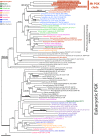Broad distribution of TPI-GAPDH fusion proteins among eukaryotes: evidence for glycolytic reactions in the mitochondrion?
- PMID: 23284996
- PMCID: PMC3527533
- DOI: 10.1371/journal.pone.0052340
Broad distribution of TPI-GAPDH fusion proteins among eukaryotes: evidence for glycolytic reactions in the mitochondrion?
Abstract
Glycolysis is a central metabolic pathway in eukaryotic and prokaryotic cells. In eukaryotes, the textbook view is that glycolysis occurs in the cytosol. However, fusion proteins comprised of two glycolytic enzymes, triosephosphate isomerase (TPI) and glyceraldehyde-3-phosphate dehydrogenase (GAPDH), were found in members of the stramenopiles (diatoms and oomycetes) and shown to possess amino-terminal mitochondrial targeting signals. Here we show that mitochondrial TPI-GAPDH fusion protein genes are widely spread across the known diversity of stramenopiles, including non-photosynthetic species (Bicosoeca sp. and Blastocystis hominis). We also show that TPI-GAPDH fusion genes exist in three cercozoan taxa (Paulinella chromatophora, Thaumatomastix sp. and Mataza hastifera) and an apusozoan protist, Thecamonas trahens. Interestingly, subcellular localization predictions for other glycolytic enzymes in stramenopiles and a cercozoan show that a significant fraction of the glycolytic enzymes in these species have mitochondrial-targeted isoforms. These results suggest that part of the glycolytic pathway occurs inside mitochondria in these organisms, broadening our knowledge of the diversity of mitochondrial metabolism of protists.
Conflict of interest statement
Figures




Similar articles
-
Compartment-specific isoforms of TPI and GAPDH are imported into diatom mitochondria as a fusion protein: evidence in favor of a mitochondrial origin of the eukaryotic glycolytic pathway.Mol Biol Evol. 2000 Feb;17(2):213-23. doi: 10.1093/oxfordjournals.molbev.a026301. Mol Biol Evol. 2000. PMID: 10677844
-
A transcriptional fusion of genes encoding glyceraldehyde-3-phosphate dehydrogenase (GAPDH) and enolase in dinoflagellates.J Eukaryot Microbiol. 2005 Jul-Aug;52(4):343-8. doi: 10.1111/j.1550-7408.2005.00042x. J Eukaryot Microbiol. 2005. PMID: 16014012
-
The tigA gene is a transcriptional fusion of glycolytic genes encoding triose-phosphate isomerase and glyceraldehyde-3-phosphate dehydrogenase in oomycota.J Bacteriol. 1997 Nov;179(21):6816-23. doi: 10.1128/jb.179.21.6816-6823.1997. J Bacteriol. 1997. PMID: 9352934 Free PMC article.
-
Energy metabolism and ageing regulation: metabolically driven deamidation of triosephosphate isomerase may contribute to proteostatic dysfunction.Ageing Res Rev. 2011 Sep;10(4):498-502. doi: 10.1016/j.arr.2011.05.003. Epub 2011 May 30. Ageing Res Rev. 2011. PMID: 21651995 Review.
-
Newly discovered roles of triosephosphate isomerase including functions within the nucleus.Mol Med. 2023 Jan 31;29(1):18. doi: 10.1186/s10020-023-00612-x. Mol Med. 2023. PMID: 36721084 Free PMC article. Review.
Cited by
-
Rethinking the evolution of eukaryotic metabolism: novel cellular partitioning of enzymes in stramenopiles links serine biosynthesis to glycolysis in mitochondria.BMC Evol Biol. 2017 Dec 4;17(1):241. doi: 10.1186/s12862-017-1087-8. BMC Evol Biol. 2017. PMID: 29202688 Free PMC article.
-
Integrated overview of stramenopile ecology, taxonomy, and heterotrophic origin.ISME J. 2024 Jan 8;18(1):wrae150. doi: 10.1093/ismejo/wrae150. ISME J. 2024. PMID: 39077993 Free PMC article. Review.
-
Evidence for loss of a partial flagellar glycolytic pathway during trypanosomatid evolution.PLoS One. 2014 Jul 22;9(7):e103026. doi: 10.1371/journal.pone.0103026. eCollection 2014. PLoS One. 2014. PMID: 25050549 Free PMC article.
-
Phosphoglycerate kinase: structural aspects and functions, with special emphasis on the enzyme from Kinetoplastea.Open Biol. 2020 Nov;10(11):200302. doi: 10.1098/rsob.200302. Epub 2020 Nov 25. Open Biol. 2020. PMID: 33234025 Free PMC article. Review.
-
Mitochondrial Glycolysis in a Major Lineage of Eukaryotes.Genome Biol Evol. 2018 Sep 1;10(9):2310-2325. doi: 10.1093/gbe/evy164. Genome Biol Evol. 2018. PMID: 30060189 Free PMC article.
References
-
- Barrett MP, Burchmore RJ, Stich A, Lazzari JO, Frasch AC, et al. (2003) The trypanosomiases. Lancet 362: 1469–1480. - PubMed
-
- Bañuls AL, Hide M, Prugnolle F (2007) Leishmania and the leishmaniases: a parasite genetic update and advances in taxonomy, epidemiology and pathogenicity in humans. Adv Parasitol 64: 1–109. - PubMed
-
- Michels PA, Bringaud F, Herman M, Hannaert V (2006) Metabolic functions of glycosomes in trypanosomatids. Biochim Biophys Acta 1763: 1463–1477. - PubMed
-
- Visser N, Opperdoes FR, Borst P (1981) Subcellular compartmentation of glycolytic intermediates in Trypanosoma brucei . Eur J Biochem 118: 521–526. - PubMed
Publication types
MeSH terms
Substances
LinkOut - more resources
Full Text Sources
Research Materials
Miscellaneous

